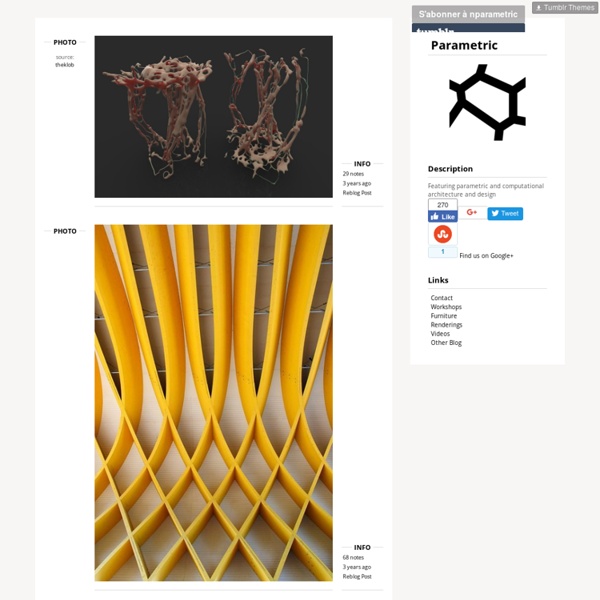



Structural Tessellations and Morphologies | 74 FOOTWEAR DESIGN CONSULTING The honeycomb is probably the epitome of structural efficiency. Bees have been creating hexagonal comb structures for millenia and humans inspired by the incredible structural strength to weight ratio of their combs have joined them. It is said that the first man-made honeycomb was made by Daedalus using gold by lost wax casting more than 3000 years ago. In 1859 Charles Darwin said that “the comb of the hive-bee, as far as we can see, is absolutely perfect in economizing labour and wax”. Little noticed is that even the the closed ends of the honeycomb cells are also an example of geometric efficiency as their trihedral shape allows two opposing honeycomb layers to nest into each other, with each facet of the closed ends being shared by opposing cells. 50 years later D’Arcy Wentworth Thompson discovered that bees build their honeycombs first as cylinders and as they push more wax onto the inside surface they also push the soft sides out and up against the neighboring cylinders.
CirclePack and circle packing General Comments: My primary research interests revolve around circle packing: connections to analytic function theory, Riemann surfaces, computational conformal structures, and applications. (see my curriculum vita.) A circle packing is a configuration of circles with a specified pattern of tangencies. Circle packings were introduced by William Thurston in his Notes. Conformal welding by my former student G. The Zoo: Here is a small menagerie of circle packings in the plane, the hyperbolic plane, and the sphere. Research Papers: Recent papers for downloading: Circle Packing Software: The Java Version 1.0 of CirclePack is now available and should run on any platform with Java 1.6++. Circle Packing Bibliography: I try to maintain a bibliography of papers on circle packing. Ways to contact me: Kenneth Stephenson, (kens "at" math.utk.edu) Department of Mathematics, Univ. of Tenn., Knoxville, TN 37996-1300 Phone: (865) 974-4330 Fax: (865) 974 6576 Last Modified: May 2007.
C_Wall View from outside the gallery door C_Wall with shadows on floor The zigzag plan of the wall creates an increased structural stiffness Dense pattern of shadows Process diagram Year: 2006Location: Banvard Gallery, Knowlton School of Architecture, Ohio State University, Columbus, OhioSize: 12′ x 4′ x 8′ Description: This project is the latest development in an ongoing area of research into cellular aggregate structures that has examined honeycomb and voronoi geometries and their ability to produce interesting structural, thermal, and visual performances. Credits: Andrew Kudless and Ivan Vukcevich with Ryan Palider, Zak Snider, Austin Poe, Camie Vacha, Cassie Matthys, Christopher Friend, Nicholas Cesare, Anthony Rodriguez, Mark Wendell, Joel Burke, Brandon Hendrick, Chung-tzu Yeh, Doug Stechschultze, Gene Shevchenko, Kyu Chun, Nick Munoz, and Sabrina Sierawski, and Ronnie Parsons
Parametric Realizations Fall 2010 | Products that explore the relationship between parametric and physical models (C)ODE-(C)OLLECTIVE: GH + Digital Script + Code Collective Inside Smartgeometry Inside Smartgeometry: Expanding the Architectural Possibilities of Computational Design Edited by Brady Peters and Terri Peters On behalf of the Smartgeometry group, we would like to invite you to the launch of "Inside Smartgeometry: Expanding the Architectural Possibilities of Computational Design" edited by Brady and Terri Peters and published by John Wiley & Sons. The richly illustrated, hard cover book features 24 original texts from members of the SG community. It provides both a history of the past ten years of SG, and offers ideas for the future of computational design in architecture. To celebrate the book´s release, join us for drinks and a few words by the Smartgeometry Directors. 21 March 2013 6.30 pm The Bartlett School of Architecture UCL, Royal Ear Hospital Ground Floor, Capper Street (corner of Huntley Street) London, WC1E 6AP Smartgeometry (SG) is a key influence on the architectural community who explore creative computational methods for the design of buildings. Robert Aish
BEE LABORATORY | ANNEMARIEMAES.NET The Bee Laboratory project monitors the behaviour of honeybees in urban surroundings. Beekeepers, scientists and artists examine the bee colonies in our rooftop gardens, our open air laboratories. We study the distributed intelligence of the honeybees : their behaviour, ecology and sociobiology. We monitor the bees and beehives with all kinds of eco-technology and we study the colony as a community. honeybee monitoring, 2009-ongoing The monitoring project offers the opportunity to study the bee colonies as bio-indicators. connected OpenGreens – the Bee Laboratory The initial setup is located in 2 rooftop gardens in the center of Brussels, at about half a kilometer distance from each other. mission statement of the Bee-lab As artists and beekeepers we study since several years the tight interaction between city honeybees and urban ecosystems. But we have also another motivation. The Bee Laboratory & UrbanBeeResearch should be seen as an open framework.
Organiser la coopération dans sa classe Il y a les treize desserts de Noël, et il y a ces treize fiches libres de droits réalisées par Pierre Cieutat, Sylvain Connac, Cyril Lascassies et Cécile Morzadec, dans le cadre d’un atelier sur la coopération entre élèves des Rencontres du CRAP-Cahiers pédagogiques en aout 2017. Il s’agissait dans cet atelier de faire vivre aux participants des formes de travail organisées en classes coopératives. Pour susciter l’aide, l’entraide et le tutorat, un plan de travail a été adossé à une partie des échanges. Chaque participant a alors pu choisir d’étudier, seul ou avec d’autres, un item correspondant à ses besoins, intérêts ou désirs. C’est dans ce cadre que ces fiches ont été mises à disposition, pour accompagner les réflexions autonomes par des ressources structurantes. Les mots de la coopération Fiche 0 - Les mots de la coopération Travail en groupe Fiche 1 - Travail en groupe L’aide et le tutorat Fiche 2 - L’aide et le tutorat Les conseils coopératifs Fiche 3 - Les conseils coopératifs